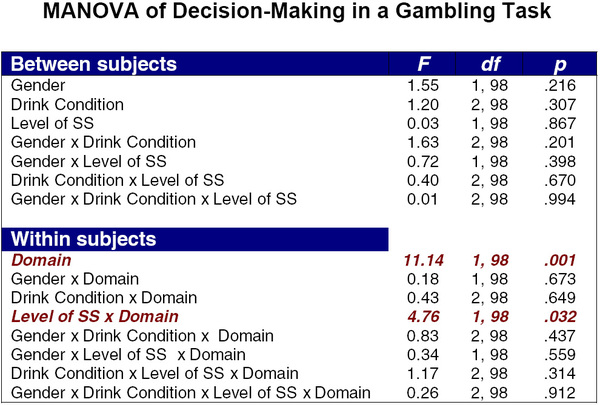The WAGER, Vol 4(38) – Drinking and Gambling: Whither the Relationship? (Part I)
The complimentary cocktail has long been a fixture on the floors of casinos. The purpose of the free drink has been the subject of debate, and several theories exist concerning its function as an incentive to gamble. Additional questions exist concerning its status as a simple courtesy on the part of the gaming industry or a chemical means of inducing gamblers to take greater risks and spend more money. It is this latter explanation that is relevant to a recently published study by Breslin, Sobell, Cappell, Vakili, and Poulos (1999). Although "comp" beverages are mentioned nowhere in the text of their article, the effect of alcohol on gambling behavior is a central concern.
Specifically, the authors set out to investigate the interaction of several variables in determining the gambling behavior of social drinkers. A sample was assembled of 53 men and 57 women, all of whom were classified as social drinkers (i.e., drinkers who consume more than 7 but less than 28 drinks weekly). Persons with psychiatric disorders, medical conditions, or pregnancies were excluded from the study. Participants were divided into one control and two experimental groups. Three scales were administered to the subjects in order to measure sensation seeking (SS) tendencies, one of the variables of interest to the authors. Members of the experimental groups were then given either a cocktail of cranberry juice and vodka or a placebo. The alcohol content of each vodka beverage was calculated to raise the breath alcohol content to a predetermined level. Subjects then began the gambling task.
Each subject was given $12 and presented with two betting setups (domains). The first domain consisted of six winning betting options for which the amount of money at stake was commensurate with the odds of winning (i.e., a one in six chance of winning $12, a six out of six chance of winning $2, etc.). The second domain consisted of six parallel losing bets. Subjects were given the opportunity to choose one betting option from each domain. Alternatively, subjects could choose to not gamble at all. After participants made their betting choices, dice were rolled to determine the outcome of each wager.
Following the experiment, the authors conducted a MANOVA (multivariate analysis of variance) with the variables of gender, betting domain preference, sensation seeking, and drinking condition. The results are presented in the table. The only meaningful influences on betting choice were betting domain and the interaction of sensation seeking and betting domain. While these findings are interesting, the most salient finding for the current discussion is that alcohol failed to influence subjects’ betting choices. That is, whether or not a subject had ingested alcohol did not discernably affect his or her betting tendencies. These findings suggest that the complimentary beverage alcohol offered by casinos may have little or no effect on patrons’ gambling behavior. Of course, there are numerous situational differences between the laboratory environment of this study and the conditions of a casino floor. It is possible that these differences may make the findings irrelevent to the experience of real casino gambling. Furthermore, since only social drinkers were employed in this study, we cannot know whether the effects would hold true for non-drinkers, problem drinkers, and other categories. Nevertheless, the present study challenges the conventional wisdom that links an abundance of beverage alcohol with changes in gambling behavior.
Sources: Breslin, F.C., Sobell, M.B., Cappell, H., Vakili, S., & Poulos, C.X. (1999). The effects of alcohol, gender, and sensation seeking on the gambling choices of social drinkers. Psychology of Addictive Behaviors, 13, 243-252.
The WAGER is funded, in part, by the National Center for Responsible Gaming, the Massachusetts Department of Public Health, the Andrews Foundation, the Addiction Technology Transfer Center of New England, the Substance Abuse and Mental Health Administration Services, and the Center for Substance Abuse Treatment.
